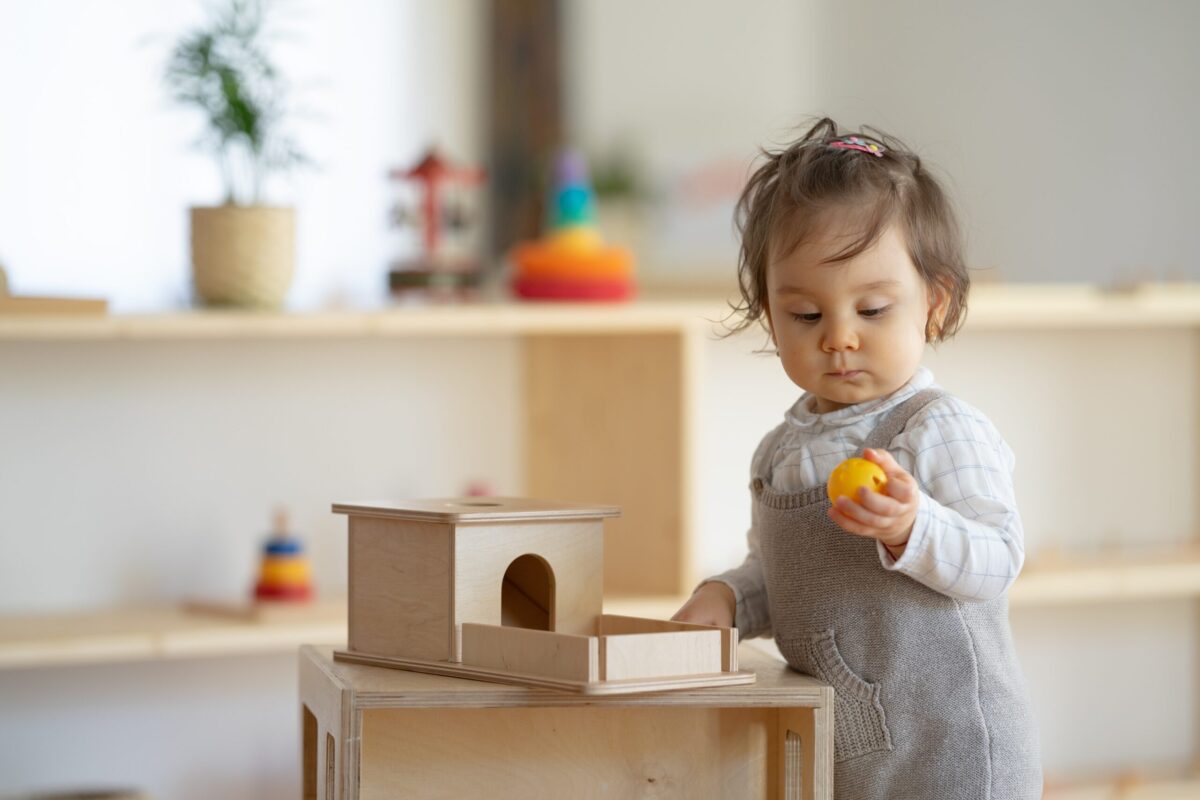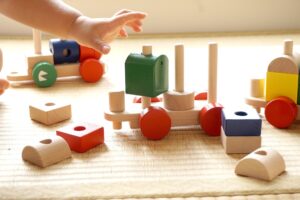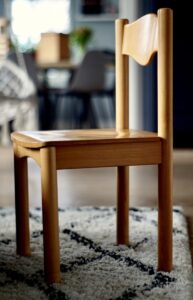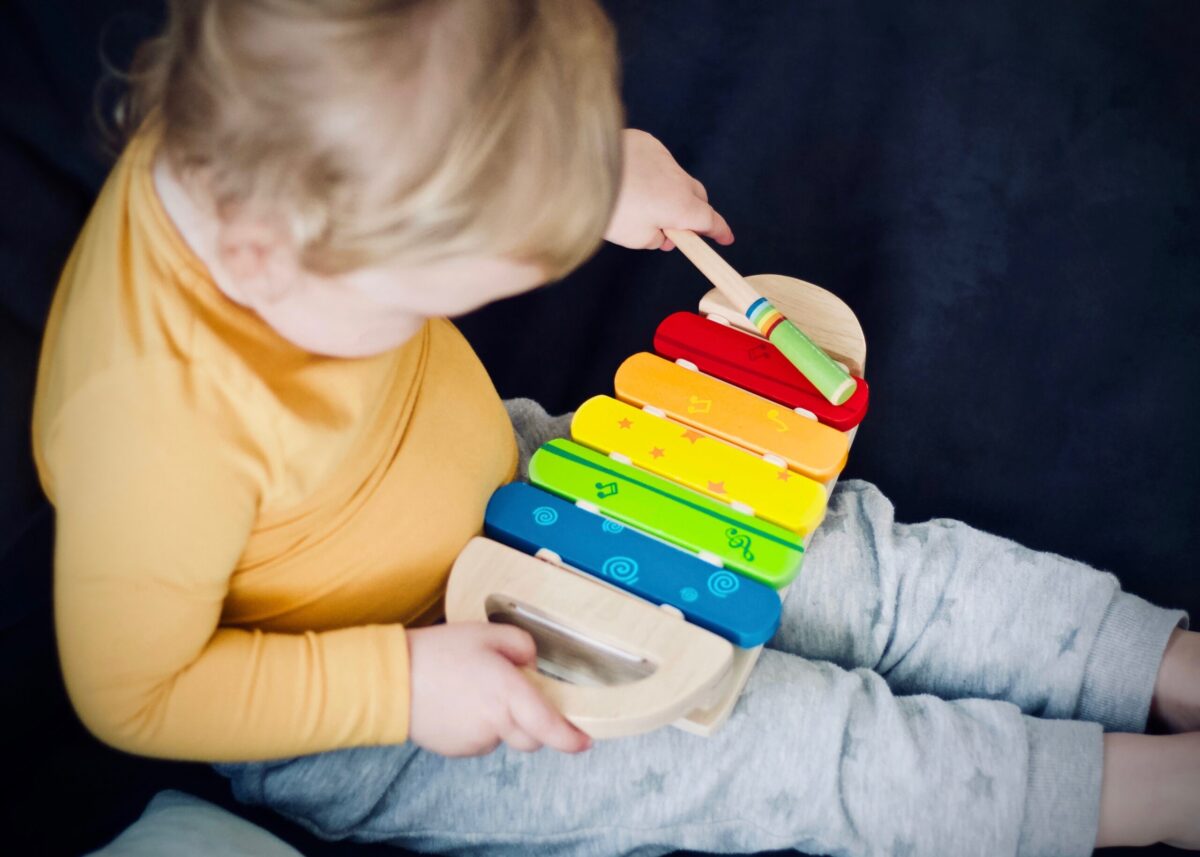A Montessori Learning Environment
If you’ve decided to bring the joy of Montessori into your home, one of your first questions may be how to set up a Montessori environment. In a nutshell, the Montessori learning environment is a space designated for children to explore, learn, and use their imaginations.
I just stumbled across a heartwarming old video of my baby girl. My chubby-cheeked, bald-headed, fully-clothed nine-month-old sat on the floor trying to put a second t-shirt on herself. With baby-awkward fingertips, she tried and tried to open the shirt. When she eventually managed to plop it onto the top of her head, she squealed with surprise that the shirt covered her eyes. Then she started all over again.
My little one was exploring, discovering, and learning with the nearest item she could reach: a tiny t-shirt.
Dr. Montessori realized that children learn through constant interactions with what surrounds them. The setting and materials around a child are not the “background” while young children learn from a teacher. Their environment is the teacher. So, in Montessori, we prepare this environment with intention.
Whether you choose your child’s playroom, a spare bedroom, or a corner of your family room, you can intentionally offer the Montessori learning environment to your own children. The Montessori principles in this article can help guide you to create a Montessori learning environment for any child in any size space.

The Montessori Learning Environment is A ‘Yes’ Space
First, the Montessori learning environment is a child-safe space where everything within it is fair game.
As Dr. Montessori said, “To assist the child, we must provide him with an environment which will enable him to develop freely.” Design your Montessori space so that your child may safely touch, open, close, lift, drop, throw, slobber on, chew, or step on anything within it.
In a “yes space,” your child will not be told, “no” or “don’t”. Your little one will be free to follow their curiosity and pursue their interests. In this space, your child will discover how to discover.
Order and Structure
Second, the Montessori learning environment offers order and structure.
 Designate this space as a clutter-free zone. Be selective about the items you allow into this special area. Avoid toys that light up or sing. Steer clear of items that are plastered in character images. Say no to small trinkets you get in party favors and kids’ meals. Say yes to quality books, blocks, wooden puzzles, and toys that promote curiosity.
Designate this space as a clutter-free zone. Be selective about the items you allow into this special area. Avoid toys that light up or sing. Steer clear of items that are plastered in character images. Say no to small trinkets you get in party favors and kids’ meals. Say yes to quality books, blocks, wooden puzzles, and toys that promote curiosity.
Present materials that follow your child’s interests. If your little one has been trying to dress herself, you might lay out a board book with clear pictures of clothing items. You could present articles of their own clothing for your child to explore, or a dressing doll with velcro, easy zippers, and large buttons.
Organize like items in child-accessible trays or baskets and keep them neat. Avoid those bottomless pits that masquerade as toy boxes. Instead, neatly lay out items for your child to discover. It can help to rotate select toys in and out of this special area. You can stash extra toys in bins in another place.
Beauty, Nature, and Reality
Third, prioritize beauty, nature, and reality. Think simple. Minimalist. Functional.
Include child-sized versions of real items, like a small wooden table and chair and real paper and writing materials. Consider including a few nontoxic plants and a miniature, real, watering can.
You can display items that go together on a single tray. This will help contain messes like spilled soil, and it will keep the space beautiful.
Your Role in a Montessori Learning Environment
As you set the stage using the guidelines above, remember that you will play a critical role long after setup. Here are a few ways you can enhance a Montessori learning environment:
Protect Concentration
Children naturally fall into periods of deep, quiet concentration as they play and explore. When your child is concentrating in this way, they seem to forget anyone or anything else is there. It’s just the child and their activity. This concentration is a critical part of the child’s learning. Try to prevent interruptions. Hold off on calling them to snack. Intercept a sibling rushing to share some news. Ride out this moment of concentration until your child moves on independently.
Follow Your Child’s Interests

Follow the principle of child-directed work — let your child’s interests guide the materials you provide them with, and let them always choose what to work with and when. For example, when your child suddenly becomes obsessed with the family dog, rotate the toys to include lifelike stuffed animals. Check out books on dogs and other animals. If the child has become fascinated by sounds, provide instruments like bells and shaker toys. Instead of nudging them to play with certain toys, let them lead the way.
Model a Love of Learning
Your child is constantly learning from you. You are their model. As a parent, there simply is no such thing as “off duty”. Your child will speak as you speak and move as you move. You can use this to your child’s advantage. Express your own curiosity. Wonder aloud. Read. When your curious child asks you question after question, give them your attention and try to answer as clearly as you can. In doing so, you can strengthen your relationship with your child while also modeling lifelong learning.
The Montessori Method
In an instant, the baby I told you about grew into a little girl. Yesterday, she noticed that when she closed the refrigerator door, the light inside the refrigerator went off. So, of course, she then opened and closed and opened and closed (and opened and closed) the door. How far could she open the door and keep the light off? What caused the light to go off? Did the food look different in the dark?
Children learn continuously through spontaneous interactions with their environment. Dr. Montessori harnessed the power and potential of children’s hands-on, trial-and-error approach to life. The result: the Montessori method.
“Because the entire Montessori method is based on the spontaneous activity of the child which is aroused precisely by the interest the child takes in the material”. – Maria Montessori
Brandi Faith is a freelance writer who holds a Master of Education degree. She earned her Bachelor of Arts degree from Northwestern University in Psychology and Spanish. Brandi passionately applies Montessori principles to her parenting and teaching at home. She loves the way Montessori philosophy encourages children to take charge of their learning and pursue their interests. Her favorite thing about Montessori is watching her kids’ eyes light up with joy and interest as they explore and experiment, and seeing their smiles light the room when they master a new skill.




0 Comments